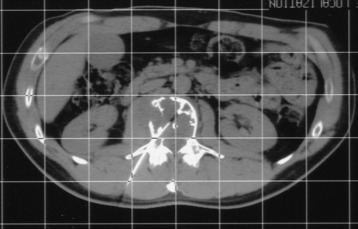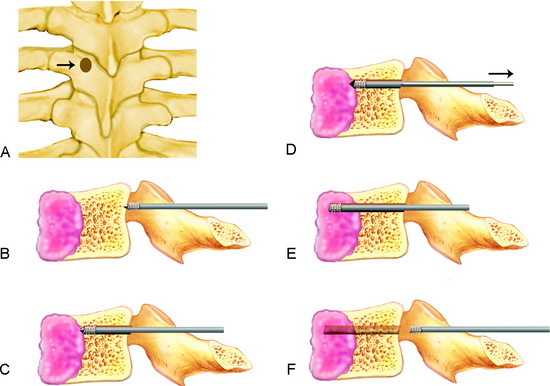Chapter 17 Percutaneous Spinal Biopsy
INTRODUCTION
Open biopsies are considered the gold standard for obtaining diagnostic tissue from spinal lesions. The accuracy rate of open biopsies has been shown to be as high as 98%. In contrast, a percutaneous needle biopsy has been reported to range between 59% and 93% in accuracy in a different series.1 The advantage of taking the percutaneous biopsy route over an open biopsy in deep-seated lesions at cervical, thoracic, and lumbar vertebral levels is well-established: it is safe, cost-effective, and less painful. A percutaneous biopsy is preferred for lesions that have a soft tissue component or are located close to vital structures, under fluoroscopic or computed tomography (CT) guidance.
APPROACH ROUTES
TRANSPEDICULAR APPROACH
The transpedicular route combines the least invasive biopsy method with conventional x-rays or CTs taken for the correct diagnosis of thoracic and lumbar lesions. This route avoids neural and vascular injury as long as the needle is intrapedicularly located (Fig. 17-1). This procedure can be performed with only anteroposterior (AP) and lateral views of the thoracic and lumbar spine. The transpedicular approach can be applied to simultaneous vertebroplasty.2 At cervical regions, CT guidance is required to perform a transpedicular biopsy.
PARASPINAL APPROACH
A transcostotransversal route can be used for thoracic vertebrae lesions. It is directed between the thoracic pedicle and rib head (Fig. 17-2). The posterolateral paraspinal route is applied to upper lumbar lesions.
TECHNIQUES
TRANSPEDICULAR APPROACH WITH FLUOROSCOPIC GUIDANCE3
Using this approach, the patient is placed in the prone position with a suitable supporter under the abdomen. Under local anesthesia with 0.5% lidocaine (Xylocaine) administered to the marked skin area, the paravertebral muscles, and the articular process of the vertebra, a threaded bone biopsy trocar (Osty-Cut, Angiomed, Karlsruhe, Germany) with an outer diameter of 2 mm is introduced through the point marked on the skin. It is then advanced to the dorsal cortex of the lamina just dorsal and lateral to the pedicle, and then into the pedicle by screwing in the trocar under guidance by observation of AP and lateral x-ray imaging. Special care is taken not to perforate the medial cortex of the pedicle to prevent injury to the nerve root or spinal cord (Figs. 17-3, A and B). It is important that the Steinmann pin be inserted into the bull’s eye of the pedicle so that complications brought about by violating the confinement of the pedicle can be avoided. To keep healthy hard bone tissue from entering the biopsy needle and clogging the lumen, which will prevent the surgeon from obtaining soft tumor tissue, the obturator should not be withdrawn until the biopsy needle has passed through the pedicle and has reached the posterior surface of the tumor mass (Fig. 17-3, C). After the trocar has advanced sufficiently, the needle is withdrawn (Fig. 17-3, D). The needle is advanced into the tumor mass and rotated. The trocar is then connected to an aspiration kit, and tissue or fluid is collected into the lumen of the trocar by aspiration at low negative pressure (Fig. 17-3, E). After a sufficient amount of tissue is obtained, the trocar is removed (Fig. 17-3, F). The collected tissue pieces are fixed in 4% buffered formalin for pathological examination.










